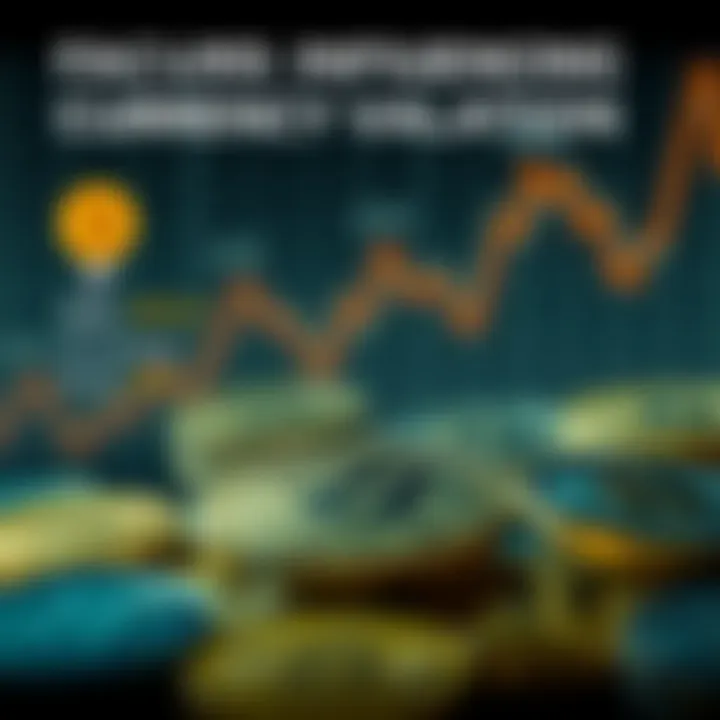Understanding the Highest Exchange Rates from USD


Intro
Understanding the highest exchange rates from the US dollar is not just for the frugal traveler or the seasoned investor. It's a complex dance of economics, international relations, and financial market strategies that can deeply influence personal finances and broader economic trends. The dynamics of foreign exchange markets hinge on numerous factors, including geopolitical events, interest rate adjustments, and economic indicators, all contributing to how currencies rise and fall against one another.
As we delve into the intricacies of currency valuation, it becomes essential to grasp the underlying mechanics that govern these exchange rates. Why does one currency soar while another plummets? How do historical contexts shape current valuations? This exploration will not only peel back the layers of currency exchange rates but also equip readers—whether investors, analysts, or curious enthusiasts—with tools and strategies to navigate this intricate realm.
By analyzing specific currencies that typically exhibit high exchange rates against the USD, we aim to foster a nuanced understanding of global finance. The journey includes discussing how certain currencies have managed to retain their value in a fluctuating market, the historical trends that underscore these shifts, and the best practices to optimize currency exchanges for different scenarios.
Hold on tight, as we embark on this exploration of the highest exchange rates from USD!
Prolusion to Currency Exchange Rates
Currency exchange rates are crucial for international trade and travel, as they determine the value of one currency against another. When looking at the exchange rates from USD, it becomes clear how interconnected global economies truly are. One tiny shift, like a change in interest rates or a political disturbance, can send ripples through multiple currencies at once.
Defining Exchange Rates
Exchange rates are essentially the price of one currency in terms of another. For instance, if you hear that the USD is exchanging at 0.90 euros, this means one US dollar can be traded for 0.90 euros.
But it isn’t just about numbers; it's about context. Factors such as supply and demand, economic indicators, and geopolitical events can cause rates to fluctuate significantly throughout the day. Thus, traders and investors constantly keep their fingers on the pulse of these rate movements to capture profitable opportunities, making the foreign exchange market a dynamic environment.
Importance of the US Dollar in Global Trade
The US dollar holds a significant position in global trade. It serves as the world's primary reserve currency, and most international transactions are conducted in USD. This phenomenon allows the dollar to maintain a higher value compared to many others, leading to high exchange rates against those currencies.
- Global Acceptance: The dollar is recognized and accepted worldwide, which simplifies cross-border transactions and investments.
- Trade Agreements: Many trade agreements hinge on USD valuations, further cementing its role in international commerce.
- Investment Vehicle: The dollar often functions as a safe haven during times of economic uncertainty, attracting global investors looking for stability.
In light of these points, it is critical for investors and travelers alike to understand how exchange rates work, especially concerning the US dollar. The ongoing movements can greatly affect purchasing power and investment strategies. As we navigate globalization, a solid grasp of these concepts is not just an academic exercise; it’s an essential skill for anyone engaging in international finance.
Understanding exchange rates may feel like a daunting puzzle, but breaking it down into simple elements makes it easier to grasp their profound implications.
By comprehending how exchange rates are defined and recognizing the substantial role the US dollar plays on the world stage, we can better prepare our strategies for investment and travel. This foundation sets the stage for a deeper exploration of the factors that influence exchange rates.
Factors Influencing Exchange Rates
Understanding the dynamics that influence exchange rates can be a linchpin for anyone involved in global finance. Exchange rates don't just fluctuate randomly; they respond to a complex interplay of economic conditions, political environments, and market behaviors. For investors, analysts, and educators, grasping these factors adds a layer of insight that can translate into favorable financial choices.
As one navigates the currency exchange landscape, several pivotal components become evident. Currency valuations serve not just as abstract numbers but as reflections of broader economic health, stability, and future expectations. Thus, comprehending these influencers can lead to a better grasp of how to optimize commerce and investment strategies.
Economic Indicators
Economic indicators are the bread and butter of any financial analysis regarding currency valuation. Figures such as GDP growth rates, employement stats, inflation rates, and trade balances can wield a significant influence on exchange rates. When a country showcases robust economic growth, its currency typically strengthens against others. Conversely, looming recession indicators often spell trouble for a currency's value.
Here are key economic indicators to watch closely:
- Gross Domestic Product (GDP): A rising GDP suggests a growing economy, encouraging investment and inflating currency values.
- Consumer Price Index (CPI): This metric shows how prices of goods are moving, influencing inflation expectations which, in turn, affect exchange rates.
- Unemployment Rate: Low unemployment can indicate a thriving market, positively affecting currency value.
"Understanding these indicators is crucial; they serve as a mirror to a nation’s economic health, reflecting its stability or the lack thereof."
Thus, for anyone keen on navigating currency markets, keeping an eye on these indicators can provide valuable foresight.
Political Stability and Economic Performance
Political stability is another critical factor. Countries with a stable political landscape tend to attract more foreign investments, thus boosting their currency's strength. In contrast, political turmoil—such as where governments face challenges or social unrest—can erode confidence and lead to currency depreciation.
Consider these aspects:


- Government Policies: The direction of governance can sway investor sentiment. For Instance, favourable trade policies enhance currency value.
- International Relations: Strong relationships can foster trade and investment, sustaining currency strength.
- Stability Indicators: Nations that maintain a steady course in governance send positive signals to markets, which can fortify their currency valuation.
Market Speculation
Finally, market speculation may perhaps be the most unpredictable yet influential factor. Traders and investors often buy or sell currencies based on anticipated future performance rather than current economic data. This can lead to fluctuations that seem disconnected from the underlying economic reality.
Key elements of market speculation include:
- Trends: Traders analyze patterns historically to predict future moves.
- Sentiment: Sometimes, market psychology reigns; if investors believe that a currency will perform well, they might buy heavily, driving up its value.
- News: Market reactions to news can cause swift changes. For instance, announcements of interest rates changes can lead to immediate market shifts.
Thus, while the foundation of exchange rates is rooted in concrete data, speculative actions can throw a curveball at expected trends.
In summation, the array of factors influencing exchange rates ranges from basic economic indicators to complex market behaviors driven by speculation. Investors need to stay informed, as these elements are not just number games; they tell a story of a country's economic narrative that can have real-life implications on trade and investment.
Identifying the Highest Exchange Rates
Understanding the highest exchange rates is essential for grasping the complexities of global finance. When one considers the dynamics of international trade and commerce, having a firm handle on how currencies fluctuate can significantly influence economic decisions. This section delves into the crucial aspects of current leading currencies and historical trends that shape the landscape of exchange rates, shedding light on their implications for investors, analysts, and travelers alike.
Current Leading Currencies
In today’s fast-paced economy, certain currencies consistently rank high against the US dollar. Exploring these currencies helps in understanding their relative strength and market acceptance. A few notable contenders include:
- Swiss Franc (CHF): Known for its stability, the Swiss Franc is often seen as a safe haven during economic downturns. Its robust banking system and neutrality make it a go-to currency for investors seeking security.
- Euro (EUR): As the official currency of the Eurozone, the Euro has made significant movements against the USD. The collective economic strength of European countries underpins its value, and it has faced fluctuations driven by political events and economic policies within member states.
- British Pound (GBP): The pound still holds historical stature and, despite challenges posed by Brexit negotiations, it remains a significant player in the forex market.
As you analyze these currencies, one must consider the underlying factors that fortify their positions. Political stability, economic performance, and even cultural attitudes towards currency influence how they are valued. By gauging these factors, one can predict potential future movements more accurately and make informed decisions.
Historic Highs: Trends Over Time
Studying historic exchange rates is akin to looking through a financial time capsule; it reveals the ebb and flow of economic factors over years. Currency values do not exist in isolation; they react to global events and economic changes. For instance, during the 2008 financial crisis, many currencies saw drastic shifts. Understanding these trends provides insight into:
- Economic Events: Major crises, trade agreements, and geopolitical conflicts have historically impacted exchange rates. The technology bubble burst of the early 2000s and the subsequent recovery phases highlight this.
- Central Bank Policies: The monetary policies set by the Federal Reserve in the US and equivalent organizations abroad can lead to significant fluctuations. For example, quantitative easing led to a devaluation of the USD making other currencies relatively stronger.
- Market Speculation: Traders adjust positions based on anticipated economic conditions. Such speculation can cause dramatic shifts in currency values overnight. The historical data illustrates how speculative impulses can lead to unexpected highs and lows.
Reflecting on historical trends not only enhances your understanding of current currency valuations but also prepares you for future market movements. Keeping an eye on both current leaders and their trajectories over time offers clarity in an inherently dynamic environment.
Case Studies of Notable Currencies
Examining specific currencies offers a clearer lens through which to view the complexities of exchange rates, especially when considering factors that influence their valuation against the US dollar. Case studies not only highlight the unique characteristics of each currency but also illuminate broader economic and geopolitical trends. By focusing on notable examples, we can grasp the nuances that make currencies like the Swiss Franc and the Kuwaiti Dinar pivotal in discussions surrounding currency exchange. These currencies provide insights into stability, investment potential, and the intricate interplay between domestic policies and international perceptions.
Swiss Franc: A Benchmark Currency
The Swiss Franc, often heralded as a safe haven, is a cornerstone in the realm of high-value currencies. Switzerland’s robust economy, characterized by low inflation, political stability, and a strong financial sector, lends significant strength to its currency. This is not merely a matter of reputation; the Swiss Franc consistently attracts investors during turbulent economic times.
- Economic Indicators: The stability of the Swiss economy is bolstered by sound fiscal policies and a thriving export sector, particularly in pharmaceuticals and technology. The country’s commitment to maintaining a high standard of living and regulated financial environment ensures that the Franc holds its ground against the dollar.
- Cultural Factors: As a nation that values neutrality, Switzerland is less affected by geopolitical tensions, making the Franc an attractive option for capital preservation. Investors often pivot to the Franc as a safeguard against market volatility.
From the perspective of currency exchange, the Swiss Franc is a barometer of investor confidence. It often serves as a reliable indicator for those looking to assess economic health and market dynamics.
Kuwaiti Dinar: The World’s Highest-Value Currency
When discussing currencies with exceptional exchange rates against the US dollar, the Kuwaiti Dinar stands tall as the highest-valued currency globally. This is attributed to several unique factors that make the Dinar a subject of interest for investors and economists alike.
- Oil Wealth: Kuwait’s wealth is predominantly sourced from its vast oil reserves. The country boasts some of the highest per capita income levels fueled by oil exports, which directly influence the Dinar's valuation. The oil sector effectively supports Kuwait’s economic framework, allowing for a strong currency position on the global stage.
- Government Policies: The Kuwaiti government implements sound fiscal policies that encourage economic growth and stability. A focus on diversifying the economy beyond oil signifies an awareness of long-term economic sustainability, which is a keen point for potential investors.
- Market Sentiment: Investor perception plays a vital role in the Kuwaiti Dinar’s standing. The attractiveness of its exchange rate, coupled with Kuwait’s strategic geopolitical position, draws attention in foreign exchange markets.
The Dinar is more than just a currency; it reflects Kuwait’s economic landscape and aspirations. For investors, understanding the factors that underpin its high value can inform strategies in trading and long-term investment.
"The Swiss Franc and Kuwaiti Dinar offer lessons in the value of stability and foresight in currency valuation. These case studies are not merely about numbers but about what they represent in a complex economic tapestry."


By diving into these case studies, we gain insights about the essential attributes that define strong currencies in the face of global economic fluctuations. Understanding their mechanisms and the implications surrounding them opens doors for better decision-making in currency exchanges.
The Role of Forex Markets
In the ecosystem of currency exchange, Forex markets serve as the backbone, dictating the ebb and flow of currencies like the US dollar. These markets are pivotal for understanding why some currencies hold more weight than others, particularly in relation to the dollar. A foreign exchange market operates 24 hours a day, allowing for continuous trading and fluid shifts in currency values.
The significance of Forex markets extends beyond just trading pairs. They are essential for investors and travelers alike, offering dynamic avenues for currency conversion, investment opportunities, and even hedging against potential losses. The intricacies of how Forex markets process vast sums of money can impact individuals' purchasing power, investment returns, and economic policies worldwide.
How Forex Trading Works
To grasp how Forex trading works, one must first familiarize themselves with some fundamental concepts. At its core, Forex trading involves buying one currency while simultaneously selling another. This is known as currency pairs. For example, when a trader buys USD/EUR, they are purchasing dollars and selling euros. Here’s how it typically unfolds:
- Market Participants: Various entities participate in Forex markets, including banks, corporations, financial institutions, and individual traders.
- Trading Platforms: Most trading occurs on electronic platforms, where currencies are traded in real-time based on current market data. Major platforms include MetaTrader and cTrader.
- Pip Movement: Currency values are determined in increments called pips, where a small percentage change can signify a large monetary difference, especially for high-volume traders.
- Leverage Usage: Traders often use leverage to amplify their investments. This means borrowing funds to increase their trading size, but it also increases risk.
Traders closely watch economic indicators and geopolitical events as they know these factors can cause significant fluctuations in currency values.
Influence of Central Banks
Central banks play a crucial role in shaping the forex landscape. Their policies and operations can have immediate and profound effects on exchange rates. Here are some key influences:
- Interest Rates: Central banks set the base interest rates for their currencies. Changes in these rates can either attract or repel foreign investment, thereby influencing demand and exchange value. Rates rising often leads to a stronger currency.
- Open Market Operations: Central banks also engage in buying or selling currency to manage money supply. Such operations can stabilize or destabilize a currency, depending on the broader economic objectives.
- Market Intervention: Occasionally, central banks may directly intervene in forex markets to mitigate extreme fluctuations or reach strategic economic aims. For instance, during economic crises, they may lower interest rates to stimulate growth.
Central bank actions are highly scrutinized by Forex market participants, as hints or announcements can trigger rapid shifts in currency valuation.
In sum, understanding Forex markets and the roles that trading mechanisms and central banks play is essential for anyone looking to navigate the complexities of global currency exchanges effectively.
Implications for Investors and Travelers
Understanding exchange rates is not just for finance nerds sitting in trading rooms; it significantly impacts both investors and travelers. As the world becomes increasingly interconnected, the implications of currency exchange rates on your portfolio or travel plans cannot be overstated. From safeguarding your investments against fluctuations to optimizing your travel budget, the knowledge of these rates can mean the difference between profit and loss, or a comfortable trip and one where you constantly have to pinch pennies.
Strategies for Currency Investment
Investing in currencies can be a goldmine, provided you do your homework. Here are a few strategies to consider:
- Diversification: Like any good investment strategy, don’t put all your eggs in one basket. Consider diverse currencies beyond the commonly traded ones. Currencies from emerging markets can provide high returns, albeit with increased risk.
- Timely Entry and Exit: Timing is crucial in this game. Keep a keen eye on economic indicators like interest rates, GDP growth, and unemployment figures, as these can give hints on future movements. Tools like currency charts can help you determine the best times to buy or sell.
- Hedging: For those who can't afford to lose their hard-earned cash, hedging can offer a safety net. Using derivatives or options allows you to protect your investments, thus minimizing losses due to adverse price movements.
- Stay Informed: Trends don't just pop up overnight. Following financial news, subscribing to market analysis, and participating in specialized forums can offer insights that can shape your decisions.
"The greatest risk is not taking one." - Anonymous
Navigating Currency Conversions
Traveling abroad often brings the headache of currency conversion. Here are some considered tactics:
- Research Rates Ahead of Time: Don’t just stroll into a currency exchange booth or bank without knowing what rates are floating around. Websites like XE.com can provide up-to-date info on exchange rates.
- Use Local ATMs: Often, withdrawing cash from local ATMs gives you a better exchange rate than what you find in exchange shops. Just keep an eye on any foreign transaction fees that might apply.
- Evaluate Your Needs: Are you a big spender or a budget traveler? If you plan on making large purchases, it may be wise to convert beforehand rather than at the airport, where rates can be sky-high.
- Utilize Apps: Many modern currency converter apps can work offline, allowing you to check rates even if you don’t have Wi-Fi access. These come handy while you are wandering in a foreign land.
In summary, keeping a close watch on exchange rates impacts investments and travel experiences, assisting with smarter decisions that can save you time and money. It’s all about strategizing and being equipped with the right information, ensuring that you’re not just another statistic in the financial world's complex dance.
Risks and Considerations
When it comes to currency exchange, understanding the associated risks and considerations is paramount. This section aims to shed light on crucial aspects that investors and travelers should keep at the forefront of their minds when dealing with exchange rates. Failing to grasp these can lead to substantial financial consequences, and a clear awareness helps in crafting effective strategies for managing these potential pitfalls.
Market Volatility
Market volatility refers to the rapid and often unpredictable price movements that currencies experience in dedicated markets. It is an essential factor influencing the exchange rates of the U.S. dollar against other currencies. In practical terms, market volatility can have a double-edged sword effect: while it can present lucrative opportunities for investors, it can also expose them to significant risks.
Several elements contribute to this volatility, including:


- Economic Reports and Data Releases: Sudden changes in economic indicators, such as inflation rates or unemployment figures, can cause immediate shifts in currency values. For instance, if the U.S. announces unexpected job growth, the dollar may strengthen against other currencies.
- Geopolitical Events: Political instability—like the ongoing negotiations in trade agreements or tensions between nations—can precipitate sharp declines or increases in currency values. Take the Brexit saga as an example; fluctuations in the pound against the dollar were frequent as the situation unfolded.
- Market Speculation: Traders often react to news and trends, inducing swings that may not always be rooted in fundamental economic realities. This speculation can lead to overreactions, creating a cycle of volatility.
Investors need to devise plans for navigating this landscape and use tools such as stop-loss orders or options to mitigate risks. It's critical to maintain a balanced approach, relying on both thorough market analysis and sound investment strategies.
Regulatory Changes
Regulatory changes constitute another vital factor in the realm of currency exchange. Governments and financial regulatory bodies periodically alter the rules that govern monetary policy, currency valuation, and trade agreements. These alterations can have far-reaching implications for exchange rates.
Considerations include:
- Foreign Exchange Controls: Some countries impose restrictions on how much currency can be exchanged or moved across borders. For investors, this can limit the ability to capitalize on favorable rates and reduce liquidity.
- Policy Statements from Central Banks: Central banks, like the Federal Reserve, routinely adjust interest rates and other monetary policies. Announcements regarding interest rate changes can steer market sentiment, affecting currency values fervently. A rise in interest rates can bolster the dollar's appeal, yet a downturn may do the opposite.
- International Trade Policies: Changes in tariffs, trade agreements, or sanctions can result in shifts in currency stability. If a nation's trade position weakens due to new policies, its currency can depreciate swiftly against others.
The understanding of regulatory frameworks allows investors to anticipate potential changes and adapt their strategies accordingly. Remaining informed about upcoming regulations and economic reports is essential for effective currency investment.
"In the world of currency exchange, ignorance isn’t bliss; it’s a fast track to mismanagement and loss."
In summary, both market volatility and regulatory changes warrant careful attention. By recognizing these risks and considering the various implications, investors and travelers can navigate the complex landscape of currency exchange with more confidence and foresight.
Future Trends in Exchange Rates
The landscape of currency exchange is as dynamic as a game of chess, with multiple elements influencing the direction of exchange rates. In this ever-evolving realm, understanding future trends in exchange rates is paramount for anyone looking to navigate the complex world of finance. This segment will delve into several specific aspects that highlight why keeping an eye on future trends is not just smart but essential.
Technological Advances in Currency Trading
Technology has fundamentally reshaped the way currencies are traded. From powerful algorithms that predict market behavior to trading platforms that offer instant access to global markets, tech innovations have created a more interconnected trading environment.
- High-Frequency Trading (HFT): Almost like the hare in the story—fast and cunning—HFT allows traders to execute orders at lightning speed. This capability can lead to the rapid change in exchange rates, resulting in opportunities for investors willing to adapt quickly.
- Algorithmic Trading: By relying on predefined criteria, algorithms systematically analyze data and execute trades based on trends, mitigating emotional decision-making. This method increases efficiency and can result in optimal pricing during volatile markets.
- Blockchain Technology: The incessant rise of blockchain offers both challenges and opportunities. As this technology ensures secure transactions, currencies built on such platforms may present new trading avenues, shifting traditional methods of exchange.
Embracing these technological trends can yield significant benefits, such as lower transaction costs and strengthened risk management. However, investors must also weave caution into their strategies, as rapid tech shifts can throw unexpected curveballs into currency trading!
Impact of Cryptocurrency on Traditional Exchange
In recent years, cryptocurrencies have stirred the pot, creating a buzz in the financial sector that just won't quit. Though often seen as a complementary form of currency, they may also pose a threat to traditional fiat currencies. The following points outline how digital currencies are influencing exchange rates:
- Decentralization: Unlike traditional currencies that are regulated by central banks, cryptocurrencies operate on a decentralized basis. This characteristic may lead to increased volatility, affecting exchange rates in unpredictable ways.
- Cross-Border Transactions: The borderless nature of cryptocurrencies can expedite transactions, enabling faster conversions compared to traditional methods. As cryptos gain more acceptance, they may shift the equilibrium of exchange rates by creating alternative avenues for currency trading.
- Changing Investor Landscape: Many investors now view cryptocurrencies as a viable asset class. The growing interest can increase demand for specific currencies, thus affecting their value on the foreign exchange market.
"Cryptocurrencies are not just a passing trend; they are reshaping the very core of currency trading and hence exchange rates."
In summary, staying attuned to these future trends is crucial for investors and analysts alike. As technology continues to evolve and cryptocurrencies gain traction, the traditional methods of exchange may have to adjust to a new reality. Keeping abreast of these changes can help investors not only survive but thrive in an increasingly complex financial landscape.
Culmination: Navigating the Currency Landscape
In today's interconnected world, understanding currency exchange rates is more than just a financial exercise; it’s a necessity for anyone involved in international trade, investment, or travel. The conclusion of this article encapsulates the critical insights gleaned from our exploration of the highest exchange rates from the US dollar. Focusing on the importance of navigating the complex landscape of currency exchanges provides not only clarity but also actionable strategies for both individuals and entities. As we wrap up, let’s delve into the key takeaways and future considerations that will arm readers with knowledge and foresight.
Summarizing Key Insights
Throughout the article, we examined various themes surrounding the dynamics of exchange rates. Here are the fundamental points to remember:
- Market Factors Shape Values: Economic indicators, political stability, and speculation influence how currencies are valued against the USD. Understanding these elements can provide an investor with the upper hand in timing their currency moves.
- Historical Context Matters: The analysis of trends over time sheds light on how specific currencies, like the Swiss Franc and Kuwait Dinar, have achieved their status. This historical perspective is essential for forecasting potential shifts in value.
- Real-World Application for Stakeholders: For businesses involved in import and export, grasping how currencies fluctuate can minimize risks and optimize profits. Investors seeking opportunities in forex markets benefit from an informed strategy that accounts for both current conditions and future challenges.
"Knowing the terrain is half the battle in the wild world of currency trading."
These insights have positioned readers to make more informed decisions, whether for investments or preparation for travel.
Looking Ahead: Preparing for Future Changes
The landscape of currency exchange is always shifting. The rapid emergence of technologies, such as blockchain and cryptocurrency, poses both challenges and opportunities. Here’s what to keep an eye on:
- Technological Innovations: The rise of digital currencies may change the way traditional forex markets operate. Understanding these new technologies can keep investors ahead of the curve.
- Regulatory Nuances: As new currencies emerge, regulatory frameworks will likely evolve. Staying updated on legislative details can help investors navigate potential pitfalls associated with abrupt changes in policy.
- Market Adaptation: As geopolitical events unfold, currencies will be affected accordingly. Developing a keen sense of market sentiment and news analysis will enhance an investor's ability to adapt swiftly.
In essence, the foresight gained from understanding current exchange rates and market conditions will prepare investors and travelers for the inevitable fluctuations their finances may face. Moreover, cultivating adaptability in response to ever-changing landscapes, coupled with readiness for futurs innovations, ensures a well-informed approach to currency navigation.















